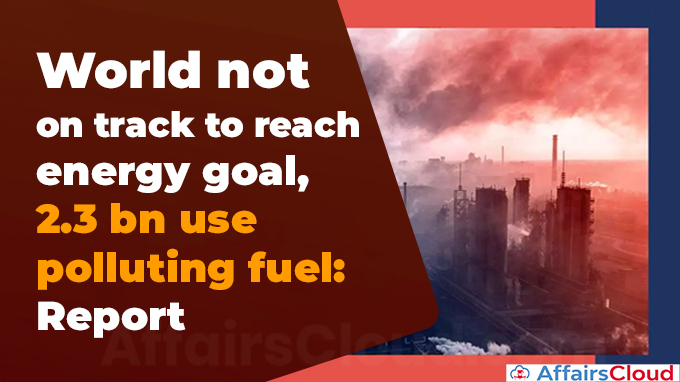 According to the report titled “Tracking SDG7: The Energy Progress 2023” released on 6th June 2023, around 2.3 billion people across the globe are still using polluting fuels and technologies for cooking and around 675 million people did not have access to electricity in 2021.
According to the report titled “Tracking SDG7: The Energy Progress 2023” released on 6th June 2023, around 2.3 billion people across the globe are still using polluting fuels and technologies for cooking and around 675 million people did not have access to electricity in 2021.
- The report states that the world is not on track to achieve the Sustainable Development Goal (SDG) 7 for energy by 2030.
- The report highlighted that despite the progress across various indicators of SDG 7 agenda, the current rates of progress is insufficient to achieve the 2030 targets.
Tracking SDG7: The Energy Progress Report:
i.The Report acts as a global reference point for information on the realization of SDG 7: Affordable and Clean Energy
ii.The report is produced annually, since 2018, by five agencies: International Energy Agency (IEA), the International Renewable Energy Agency (IRENA), the United Nations Statistics Division (UNSD), the World Bank, and the World Health Organization (WHO), which are responsible for tracking global progress toward SDG7.
Access to Clean Fuels & Technologies For Cooking:
It is estimated that around 71% of the world’s population had access to clean cooking fuels and technologies in 2021. This represents an increase of 2%
points since 2020 and 14 points since 2000.
- The usage of polluting fuels and technologies increases the risk of chronic diseases among household members(especially women and children).
- This also contributes to climate change, perpetuating gender inequity, and compromising actions for sustainable development.
The report stated that around 1.9 billion people across the globe will not have access to clean cooking in 2030.
- If the current rate of progress continues, around 6 out of 10 people without access to clean cooking in 2030 would reside in Sub-Saharan Africa.
Note: Around 3.2 million people across the globe die due to illness caused due to polluting fuels and technology, which increases exposure to toxic levels of household air pollution.
Access to Electricity:
Globally, access to electricity grew by an annual average of 0.7% points between 2010 and 2021. The pace of annual growth slowed during 2019–21 to 0.6% points
- In 2010, 84% of the world’s population had access to electricity. This increased to 91% in 2021.
- More than 80% of those without electricity(around 567 million in 2021) reside in sub-Saharan Africa, similar to the deficit in 2010.
International financial flows to developing countries in support of clean energy research and development and renewable energy production, including in hybrid systems, in 2021 was about USD 10.8 billion
About International Energy Agency (IEA):
Executive Director– Fatih Birol
Headquarters– Paris, France
Established in 1974




